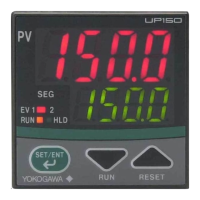
Do you have a question about the YOKOGAWA UP150 and is the answer not in the manual?
| Brand | YOKOGAWA |
|---|---|
| Model | UP150 |
| Category | Temperature Controller |
| Language | English |
Explains symbols used in the manual for safety and warnings.
Details the PV/SP displays, SEG, RUN, HLD, EV lamps.
Explains the operation of SET/ENT, RUN, RESET keys.
Lists criteria for selecting a suitable installation site.
Step-by-step guide for physically mounting the controller.
Provides cutout and external dimensions for standard mounting.
Provides dimensions for side-by-side installation.
Emphasizes electrical safety and qualified personnel for wiring.
Offers advice on power sources, filters, and protection.
Lists recommended cables and terminals for connections.
Details PV input, SP output, alarms, and power supply specifications.
Covers safety standards, environmental conditions, and construction.
Details maximum effects from operating conditions and performance metrics.
Explains how to move between parameter and operating displays.
Describes how to change setpoints and parameter values.
Details how to select and set measured input ranges.
Step-by-step guide to change the control mode of the UP150.
Lists parameters frequently adjusted during operation.
Lists parameters that are less frequently changed.
Details parameters used for creating programs and segments.
Explains specific parameters like CTL, MR, HYS, FL, BS, DIS.
Shows a practical example of a program pattern.
Provides a template for defining program patterns.
Step-by-step guide for defining program operations.
How to initiate a programmed operation.
How to halt or reset a running program.
Method for creating programs by setting segment times and setpoints.
Explains various methods to start program execution.
How program starts based on current PV and time settings.
How program starts based on current PV and ramp settings.
Details starting with ramp-only segments.
Explains starting based on soak or no-soak segments.
Describes PV event types, codes, and their relay actions.
Explains time event functionality, including on/off times and notes.
Details how wait operation uses a zone to transition segments.
Explains how program operation is paused during hold.
Describes how to move forward to the next program segment.
Explains how advancing affects time event status.
Defines program termination behaviors (Reset, Hold, Repeat).
Lists common error displays and their solutions.
Identifies signs requiring repair and power failure effects.